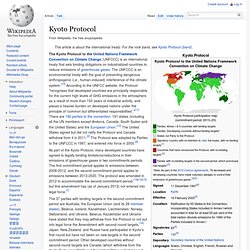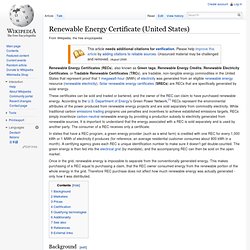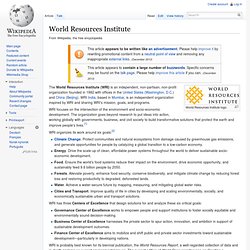

Emissions trading. A coal power plant in Germany. Due to emissions trading, coal may become a less competitive fuel than other options. Emissions trading or cap and trade is a market-based approach used to control pollution by providing economic incentives for achieving reductions in the emissions of pollutants.[1] A central authority (usually a governmental body) sets a limit or cap on the amount of a pollutant that may be emitted. The limit or cap is allocated or sold to firms in the form of emissions permits which represent the right to emit or discharge a specific volume of the specified pollutant. Firms are required to hold a number of permits (or allowances or carbon credits) equivalent to their emissions. The transfer of permits is referred to as a trade. Emission Reduction Unit. The Emission reduction unit (ERU) is an emissions unit issued under a Joint Implementation project in terms of the Kyoto Protocol. An ERU represents a reduction of greenhouse gases under the Joint Implementation mechanism, where it represents one tonne of CO2 equivalent reduced.[1] To allow comparison between the different effects of gases on the environment, scientists have defined multipliers for gases that compare their greenhouse potency (global warming potential) relative to that of carbon dioxide.
One example of a Joint Implementation project resulting in an emission reduction unit, is the production of biogases by landfill sites. These gases consist of mainly methane which escapes to the atmosphere if it is not collected. The main reason for dealing with methane is that it has a 100-year global warming potential multiplier of 25[2] compared to carbon dioxide (i.e. has 25 times the greenhouse potency).
Certified Emission Reduction. Certified emission reduction units (CERs) by country of origin October 2012 Certified emission reduction units (CERs) monthly spot prices 2012 Certified Emission Reductions (CERs) are a type of emissions unit (or carbon credits) issued by the Clean Development Mechanism (CDM) Executive Board for emission reductions achieved by CDM projects and verified by a DOE under the rules of the Kyoto Protocol. CERs can be used by Annex 1 countries in order to comply with their emission limitation targets or by operators of installations covered by the European Union Emission Trading Scheme (EU ETS) in order to comply with their obligations to surrender EU Allowances, CERs or Emission Reduction Units (ERUs) for the CO2 emissions of their installations.
CERs can be held by governmental and private entities on electronic accounts with the UN. Carbon offset. United Nations Framework Convention on Climate Change. The United Nations Framework Convention on Climate Change (UNFCCC) is an international environmental treaty negotiated at the United Nations Conference on Environment and Development (UNCED), informally known as the Earth Summit, held in Rio de Janeiro from 3 to 14 June 1992.

The objective of the treaty is to "stabilize greenhouse gas concentrations in the atmosphere at a level that would prevent dangerous anthropogenic interference with the climate system".[2] The treaty itself set no binding limits on greenhouse gas emissions for individual countries and contains no enforcement mechanisms.
In that sense, the treaty is considered legally non-binding. Instead, the treaty provides a framework for negotiating specific international treaties (called "protocols") that may set binding limits on greenhouse gases. Kyoto Protocol. Kyoto Parties with first period (2008–12) greenhouse gas emissions limitations targets, and the percentage change in their carbon dioxide emissions from fuel combustion between 1990 and 2009.

For more detailed country/region information, see Kyoto Protocol and government action. Category:Carbon finance. Renewable Energy Certificate (United States) Renewable Energy Certificates (RECs), also known as Green tags, Renewable Energy Credits, Renewable Electricity Certificates, or Tradable Renewable Certificates (TRCs), are tradable, non-tangible energy commodities in the United States that represent proof that 1 megawatt-hour (MWh) of electricity was generated from an eligible renewable energy resource (renewable electricity).

Solar renewable energy certificates (SRECs) are RECs that are specifically generated by solar energy. These certificates can be sold and traded or bartered, and the owner of the REC can claim to have purchased renewable energy. According to the U.S. Department of Energy's Green Power Network,[1] RECs represent the environmental attributes of the power produced from renewable energy projects and are sold separately from commodity electricity. CDM Gold Standard. The Gold Standard is a standard for creating high-quality emission reductions projects in the Clean Development Mechanism (CDM) Joint Implementation (JI) and Voluntary Carbon Market. It was designed to ensure that carbon credits are not only real and verifiable but that they make measurable contributions to sustainable development worldwide.
Its objective is to add branding, a label to existing and new Carbon Credits generated by projects which can then be bought and traded by countries that have a binding legal commitment according to the Kyoto Protocol. History[edit] World Resources Institute. World Resources Institute logo.

The World Resources Institute (WRI) is an independent, non-partisan, non-profit organization founded in 1982 with offices in the United States (Washington, D.C.) and China (Beijing). WRI India, based in Mumbai, is an independent organization inspired by WRI and sharing WRI's mission, goals, and programs. WRI focuses on the intersection of the environment and socio-economic development. The organization goes beyond research to put ideas into action, working globally with governments, business, and civil society to build transformative solutions that protect the earth and improve people's lives.[1] WRI organizes its work around six goals:[2] Climate Change. WRI has three Centers of Excellence that design solutions for and analyze these six critical goals: WRI is probably best known for its biennial publication, the World Resources Report, a well-regarded collection of data and in-depth analysis on current environmental issues. Clean Development Mechanism. Joint Implementation.
Joint implementation (JI) is one of three flexibility mechanisms set out in the Kyoto Protocol to help countries with binding greenhouse gas emissions targets (so-called Annex I countries) meet their obligations. JI is described in Article 6 of the Kyoto Protocol.[1] Under Article 6, any Annex I country can invest in an emission reduction project (referred to as a "Joint Implementation Project") in any other Annex I country as an alternative to reducing emissions domestically.
In this way countries can lower the costs of complying with their Kyoto targets by investing in projects that reduce greenhouse gas emissions in an Annex I country where reducing emissions may be cheaper, and then using the resulting Emission Reduction Units (ERUs) towards their commitment goal. A JI project might involve, for example, replacing a coal-fired power plant with a more efficient combined heat and power plant.
The process of receiving credit for JI projects is somewhat complex. Greenhouse gas. Since the beginning of the Industrial Revolution (taken as the year 1750), the burning of fossil fuels and extensive clearing of native forests has contributed to a 40% increase in the atmospheric concentration of carbon dioxide, from 280 ppm in 1750 to 392.6 ppm in 2012.[5][6] It has now reached 400 ppm in the northern hemisphere.

In the Solar System, the atmospheres of Venus, Mars, and Titan also contain gases that cause a greenhouse effect, though Titan's atmosphere has an anti-greenhouse effect that reduces the warming. Gases in Earth's atmosphere[edit] Greenhouse gases[edit] Greenhouse gases are those that can absorb and emit infrared radiation,[1] but not radiation in or near the visible spectrum.